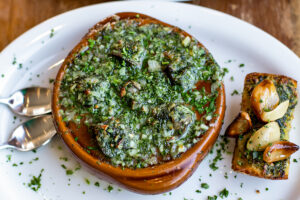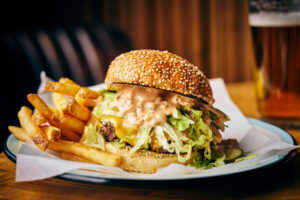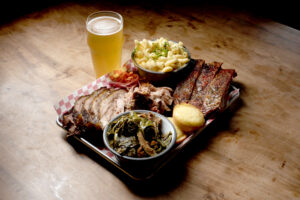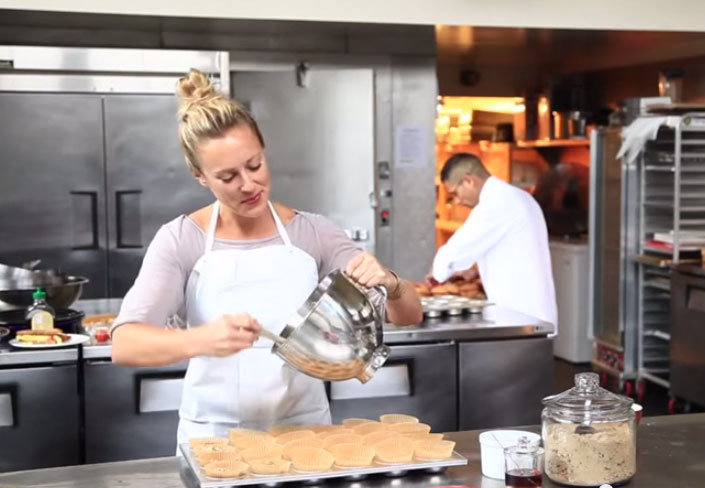
From roasted ants to deep fried cicadas, more than one-third of the world’s population regularly relishes insects as a source of dietary protein. But could you?
Before wincing at the idea of McHissing Cockroaches and the Bucket ‘O Dung Beetles coming to U.S. menus anytime soon, think about this: Eating bugs might just save the planet.
According to a recent study by the Food and Agriculture Organization of the United Nations, the global population will reach 9 billion in the next 35 years (up from about 7 billion in 2012) and current food production will have to double to even begin to feed that many people. With land, water and other resources already stretched thin, entomophagy (bug eating) may help stabilize the global food supply.
Here in the Bay Area, a tiny-but-growing company called Bitty Foods is leading the charge toward edible insects with chocolate chip cookies. Or more specifically, chocolate chip cricket flour cookies.
[blockquote]“If we are going to extend the shelf life of our own species, this is super important” – Chef Tyler Florence on alternative forms of protein, like crickets.[/blockquote]
Using their proprietary blend of dried, roasted and ground crickets (blended with cassava and coconut flours for texture and taste), co-founder Megan Miller said Bitty sells about 500 bags of gluten-free chocolate chip, chocolate cardamom and orange ginger cookies in their East Bay kitchens each week. Currently available only online, the company also makes about 600 pounds of cricket flour each week, and they’re having a hard time keeping up with demand.
In fact, the company has even attracted the attention and financial backing of celebrity chef Tyler Florence, who lives in Marin. “If we are going to extend the shelf life of our own species, this is super important,” said Florence of his passion for cricket cuisine. Despite having part ownership in a steakhouse, Florence said beef is ultimately unsustainable, especially in light of recent draughts. When he talks about Bitty, he’s almost giddy, planning new recipes and uses for the flour. “We want this to be big,” he said.
Florence’s enthusiastic endoresment is also good for Bitty’s image and growth. “People love Tyler, and if he says something is delicious, they’re surprisingly willing to taste,” said Miller. “When I first started this, I thought I would have to spend a lot of time convincing people. But we’ve doubled our sales month over month. It’s been incredible that a lot of people are saying that they really get it,” Miller said, “It’s not the taste, it’s the mental barrier.”
Less daunting than, say meal worms or stink bugs, crickets have become the poster-insects for Bitty. “Crickets are something people can grasp. They’re closely related to shrimp, and they’re familiar,” said Bitty Co-founder Megan Miller. “Some people even call them Land Shrimp,” she said, alluding to the flavor of crickets. “It gets across the idea,” she added. In addition to Bitty, several other cricket-based food companies have emerged, including Six Foods, Chapul and Exo cricket bars.
But it’s not all about the novelty factor of eating insects. It’s about simple math. Beef can use up to 1,000 gallons of water and ten pounds of food to make a single pound of meat. By comparison, pigs use about 600 gallons of water and 5 pounds of feed, chickens about 150 gallons and 2.5 pounds of feed. For a pound of cricket protein (roughly 4,000 insects), it takes 1 gallon of water and two pounds of feed. Insects can be raised in small areas, reproduce exponentially, and require little care. Cricket flour is significantly higher in protein, lower in fat and rich in minerals, according to USDA research, making it especially interesting to Paleo and other protein-rich, gluten free diets.
Eating bugs, for most Westerners, is a tough sell. Bugs have gotten the wrap of being creepy, dirty, unwelcome pests rather than a food source. But for most of history, they’ve been a diet staple, from our earliest ancestors through Roman times as gastronomic delicacies. In equatorial climates, bugs tend to be larger and more prevalent, making them an obvious source of protein. And, when it comes right down to it, Americans unwittingly eat up to two pounds of insects a year in our food, based on FDA guidelines allowing small amounts of insect contaminants in most of what we eat.
So where do you get roughly 2.4 million crickets a week? Cricket farms, of course. The insects are raised on large commercial farms throughout the country with growth from egg to adult in less than 6 weeks, and Miller claims that female crickets can lay up to 15,000 eggs, making for a highly sustainable source of protein. They are harvested by being frozen, then dried, roasted and ground.
Obviously, not everyone can afford a $20 pound of cricket flour, so the key to ramping up insect production on a mass scale. Funding from Florence and other backers is expected to ramp up their production from a small, artisan operation to a baking ingredient available at major retailers.
And the taste? The flour is a bit like buckwheat, with a nutty, grassy flavor. Baked into gluten-free muffins, pastries and cookies, moms are some of her biggest buyers. “Sometimes its a challenge for moms to get their kids to eat meat, but if you can give them a serving of cookies, they’ll always eat that,” Miller said.
“We’re going to have to base our diets on plants and other protein sources lower on the food chain, and that includes insects. We just have to be more innovative about feeding people,” said Miller.
You can buy Bitty Foods cricket flour and cookies online at Bittyfoods.com. Miller hopes to have them at other retailers like Berkeley Bowl and Whole Foods within the next year.
[infobox color=”#d8d8d8″ icon=”bug”]Hungry for a bite of crickets for dinner? Chapulines (roasted crickets) are popular in the Oaxacan region of Mexico, and are often available in Mexican markets. Agave Mexican Restaurant and Tequila Bar (1063 Vine St., Healdsburg, 707-433-2411) features Chapulines on their menu, according to owner Octavio Diaz, but it’s best to call ahead to make sure they’re serving them. There’s always the backyard, as well. Bitty Foods’ Miller says that eating wild-foraged crickets is not necessarily a bad thing if you know where they’ve been, but the FDA requires farm-raising for commercial use to regulate sanitary conditions and contaminants.[/infobox]










